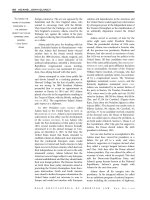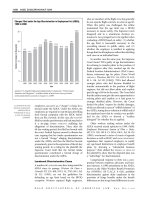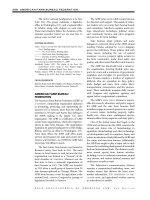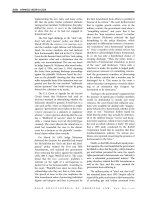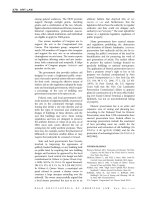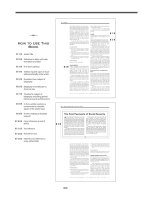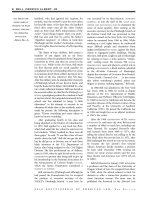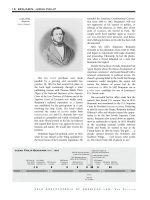Gale Encyclopedia Of American Law 3Rd Edition Volume 2 P11 pptx
Bạn đang xem bản rút gọn của tài liệu. Xem và tải ngay bản đầy đủ của tài liệu tại đây (500.02 KB, 10 trang )
eyewitnesses; all the reports were decidedly in
support of the colonists. The pamphlet, how-
ever, was not distributed in Boston, due to the
belief that it might interfere with the fairness of
the trial.
The trial became a controversial issue with
political aspects. In addition to the murder
charge, the legal action intensified the struggle
between the King’s men, who desired a verdict
in their favor to counteract the tactics of
Samuel Adams, and the colonists, who wanted
the trial to be an example to Parliament against
further use of the
MILITIA to restrain their
freedom.
Lieutenant Governor Hutchinson believed
that an immediate court hearing would be
detrimental and unfair to the King’s men; he
advocated a series of postponements and the
trial finally began in the fall of 1770.
ROBERT
TREAT PAINE
served as PROSECUTOR, and JOHN
ADAMS
(cousin to Samuel Adams) and Josiah
Quincy were the defense counselors.
The trial progressed and arguments were
presented for both sides. The defense was
determined to prove that the soldiers were acting
in
SELF-DEFENSE. The prosecution attempted to
show that the soldiers were guilty of malice with
intent to kill.
Captain Preston was tried separately (there
is evidence that the jury was packed in his favor).
He was acquitted and he hastily left Boston.
Eight soldiers were next brought to trial and
six were acquitted. The remaining two soldiers
were found guilty of
MANSLAUGHTER (as opposed
to murder). The method of pu nishment was
branding on the thumb. The two soldiers,
Matthew Killroy and Hugh Montgomery, re-
ceived their penalty and were discharged from
the military.
The irony of the Boston tragedy is that it
need never have occurred. Shortly before the
night of the bloodshed Parliament had decided
to repeal the
TOWNSHEND ACTS that had so greatly
agitated the colonists. Word of this decision did
not reach Boston until later.
The acts were revoked later in 1770, after
the Boston Massacre; one tax remained, how-
ever, and that was a minimal tax on tea. This tea
tax would later precipitate the Boston Tea Party.
BOTTOMRY
A contract, in maritime law, by which money is
borrowed for a specified term by the owner of a
ship for its use, equipment, or repair for which the
ship is pledged as collateral. If the ship is lost in
the specified voyage or during the limited time, the
lender will lose his or her money according to the
provisions of the contract. A contract by which a
ship or its freight is pledged as security for a loan,
which is to be repaid only in the event that the
ship survives a specific risk, voyage, or period.
A bottomry bond is the instrument that
embodies the contract or agreement of bottomry.
v
BOUDINOT, ELIAS
The first lawyer admitted to practice before the
U.S. Supreme Court was New Jersey patriot
ELIAS BOUDINOT. A good friend of President
George Washington’s, Boudinot was a promi-
nent public official who strongly supported the
American Revolution. Boudinot held sever al key
positions in the
CONTINENTAL CONGRESS and
signed the 1783 peace treaty with England
after the United States’ victory in the
WAR OF
INDEPENDENCE
. After the war he aligned himself
with Federalists
JOHN ADAMS and ALEXANDER
HAMILTON
. Like them, Boudinot supported a
strong, centralized national government and
distrusted many of the principles of participa-
tory democracy.
Born May 2, 1740 , in Philadelphia, Boudi-
not studied law and was admitted to the New
Jersey bar in 1760. By 1770 he had risen to the
prestigious level of
SERJEANT AT LAW. Although
Boudinot began his career as a political conser-
vative, he eventually supported the colonies’
On March 5, 1770,
English soldiers fired
into a crowd of angry
colonists, killing five.
Two of the soldiers
were later found
guilty of
manslaughter.
LIBRARY OF CONGRESS
GALE ENCYCLOPEDIA OF AMERICAN LAW, 3
RD E DITION
88 BOTTOMRY
efforts to break away from English domination.
He joined the Revolutionary party after the U.S.
War of Independence erupted and served as
deputy of New Jersey’s provincial assembly.
Boudinot was a representative to the Con-
tinental Congress from 1777 to 1784. He was
president of the Congress from 1782 to 1784
and was named secretary of foreign affairs. He
became commissary general of prisoners in
1777 and donated a large sum of his own
money to help improve prison conditions. In
1787 Boudinot played a key role in obtaining
New Jersey’s
RATIFICATION of the new U.S.
Constitution.
In 1789 Boudinot became a member of the
House of Representatives from New Jersey,
holding office during the first three sessions
of Congress. Once the U.S. Supreme Court was
officially established, Boudinot became the
first lawyer admitted to practice before it, on
February 5, 1790. He also served as a trustee of
Princeton University and was director of the
U.S. Mint in Philadelphia from 1795 to 1805.
In the later years of his life, Boudinot’s
interests turned from politics to evangelical
theology. Founder and president of the Ameri-
can Bible Association, Boudinot proposed a
universal acceptance of
RELIGION as a cure for
society’s ills.
Boudinot died in New Jersey on October
24, 1821, at age 81.
BOUNDARIES
Boundaries are natural or artificial separations
or divisions between adjoining properties that
show their limits.
Boundaries are used to establish private
and public ownership by determining the exact
location of the points at which one piece of land
is distinguishable from another. They are also
used to mark the functional and jurisdictional
limits of political subdivisions. For example, in
the United States, boundaries are used to define
villages, towns, cities, counties, and states.
The setting of boundaries is a characteristic
of the modern era of history during which
centralized states emerged that required both
protection against attacks and definition of their
populations. Historically, natural objects such
as rivers and mountains served this purpose.
Accurate determination of boundaries requires
surveying and cartography, which were not
widely used until the early nineteenth century.
But even in the early 2000s, with scientific
information methods available, mapmakers
occasionally are forced to turn to ancient
landmarks and memories when attempting to
set boundaries. For example, for centuries the
borders within the Arabian peninsula had been
loosely defined by tribes’ grazing patterns.
Following Saddam Hussein’s invasion of Kuwait
and subsequent defeat in 1991,
UNITED NATIONS
mapmakers attempted to det ermine the exact
border between Iraq and Kuwa it. The United
Nations enlisted the help of British border
expert Julian Walker, who sought out elderly
guides who could describe the locations of
landmarks referred to in earlier records and
provide a starting place for demarcation of the
border.
Several types of maritime boundaries exist,
such as the territorial sea, which is a belt of
coastal waters—controlled by the adjacent state
and subject to rights such as those of foreign
ships to passage—whose boundary is a line
measured three miles from the low-water mark
along the shore; contiguous zones, which
extend beyond the territorial sea to a maximum
THERE ARE NO
EXPRESS WORDS
;
AND THIS IS THE CASE
WITH MOST OF THE
POWERS EXERCISED
BY
CONGRESS.
—ELIAS BOUDINOT
Elias Boudinot 1740–1821
❖
❖
◆
◆
◆
◆
◆
◆
1740 Born,
Philadelphia, Pa.
1760 Admitted to
New Jersey bar
1775 American Revolution began
1777–84 Served
as representative
to the Continental
Congress
1787 Helped obtain New Jersey's
ratification of new U.S. Constitution
1795–1805 Served as
director of the U.S.
Mint in Philadelphia
1790 Became first lawyer admitted to
practice before U.S. Supreme Court
1788 Elected from New Jersey to
U.S. House of Representatives
1816 Founded
the American
Bible Association
1821 Died,
Burlington,
N.J.
▼▼
▼▼
17501750
17251725
17751775
18001800
18251825
GALE ENCYCLOPEDIA OF AMERICAN LAW, 3RD E DITION
BOUNDARIES 89
of twelve miles, within which the controlling
state may act to prevent or punish violations of
its regulations; and a two-hundred-mile exclu-
sive economic zone, subject to a nation’s rights
of exploration, exploitation, conservation, and
management of marine life, which was autho-
rized by the Third United Nations Conf erence
on the
LAW OF THE SEA.
Marine boundaries provide fertile ground
for international conflict. In June 1990, the
United States and the Soviet Union signed an
agreement resolving a 1,600-mile-lon g maritime
boundary dispute that began in 1977. The area
at issue, some 21,000 square nautical miles,
contained valuable fishing grounds and possible
oil and gas fields. The conflict had its origins in
1867, when czarist Russia sold Alaska to the
United States. It was not until more than 100
years later, while establishing their respective
200-mile fisheries zones off the coasts of Alaska
and Siberia in the Bering Sea, Chukchi Sea, and
Arctic Ocean, that the two countries realized
they had each set a different boundary for
Alaska.
Even marine boundaries that have been
widely accepted for years can be suddenly
ignored. For example, in March 1995 Canada
seized a Spanish trawler fishing for halibut in
international waters just beyond Canada’s 200-
mile boundary. Foreign Affairs Minister Andre
Ouellet of Canada claimed that a catastrophic
decline in fishing stock in recent years gave
Canada moral authority to extend its jurisdic-
tion beyond the internationally recognized 200-
mile maritime limit.
Boundaries in
INLAND WATERS, such as the
Canadian-U.S. boundary through the Great
Lakes, follow a median line equidistant from
the opposite shores. Boundaries in navigable
rivers are set at the middle of the thalweg, which
is the deepest or most navigable channel, as
distinguished from the geographic center or a
line midway between the banks (United States v.
Louisiana, 470 U.S. 93, 105 S. Ct. 1074, 84 L. Ed.
2d 73 [1985]). As the thalweg shifts owing to the
accumulation of sediment in the river, the
geographic boundary also shifts. The island
exception to the rule of thalweg provides that if
there is a divided river flow around an island, a
boundary once established on one side of the
island remains there, even if the main down-
stream navigation channel shifts to the island’s
other side (Louisiana v. Mississippi, 516 U.S. 22,
116 S. Ct. 290, 133 L. Ed. 2d 265 [1995]).
Boundary disputes between states often
attract attention from the media and from legal
scholars because they invoke the U. S. Supreme
Court’s seldom-used
ORIGINAL JURISDICTION. The
most typical path to the nation’s high court is by
APPEAL, either from a federal court of appeals or
a state supreme court. Article III, Section 2 gives
the Court original jurisdiction to try cases
“affecting Ambassadors, other public Ministers
and Consuls, and those in which a State shall
be a Party.”
In 1993 the state of New Jersey filed a
complaint in the Supreme Court against the
state of New York, alleging that filled portions
of Ellis Island belonged to New Jersey. In 1834
a
COMPACT between New York and New Jersey,
Within the
boundaries of an
exclusive economic
zone, a nation has the
right to drill for oil,
explore, and manage
marine life.
AP IMAGES
GALE ENCYCLOPEDIA OF AMERICAN LAW, 3
RD E DITION
90 BOUNDARIES
approved by Congress, established the boundary
line between the states as the middle of the
Hudson River. Ellis Island, then only three
acres, became part of New York according to
the compact. The United States in 1891 decided
to use Ellis Island as a port to receive immi-
grants. Over the next 42 years, the federal
government added 24.5 acres to the island to
facilitate its use as a portal for the more than
100 million immigrants who passed through
the island facilities. Although the Ellis Island
IMMIGRATION Center closed in 1954, the site has
remained an important historical landmark.
The Supreme Court in 1994 appointed a
SPECIAL
MASTER
, Paul Verkuil, to determine whether
the filled portion of the island belonge d to
New York or to New Jersey (New Jersey v. New
York, 513 U.S. 924, 115 S. Ct. 309, 130 L. Ed. 2d
273 [1994]). Verkuil found that, although the
original 1834 compact designated the island as
the property of New Jersey, the compact did
not establish boun daries for the filled portions
of the island. In a report filed with the Court
in 1997 (520 U.S. 1273, 117 S. Ct. 2451, 138
L. Ed. 2d 209 [1997]), Verkuil concluded the
filled portions belonged to New York according
to the original compact, which set the boundary
line as the middle of the Hudson River. In
1999, the Supreme Court concurred with the
special master in its final order and decree
(526 U.S. 589, 119 S. Ct. 1743, 143 L. Ed. 2d
774 [1999]).
New Jersey also had recurrent issues with
Delaware involving the shared boundary of
the Delaware River separating the states. The
first matter was settled in 1907 by a compact
addressing respective fishing right s, but the
compact did not address the interstate bound-
ary line in the river (New Jersey v. Delaware I,
205 U.S. 550 [1907]). In 1934 the Supreme
Court settled the second dispute by determining
the location of the boundary (New Jersey v.
Delaware II, 291 U.S. 361 [1934]). In New Jersey
v. Delaware III (128 S. Ct. 1410, 552 U.S. ___
[2008]), the Delaware Department of Natural
Resources refused to let British Petroleum (BP)
America construct a liquefied natural gas
terminal projected to extend some 2,000 feet
beyond the New Jersey shore into Delaware
territory. The Supreme Court, by a 6-2 margin,
sided with Delaware. It held that, while
Delaware could not interfere with ordinary
projects, it had the right to regulate industrial
development that affected Delaware’s waters
and coastline, even though the project was
based, and began in, New Jersey.
A prior Supreme Court decision involved
the states of New Hampshire and Maine. New
Hampshire officials filed a lawsuit asking the
Supreme Court to decide whether the Ports-
mouth Naval Shipyard is located in one state
or the other. At stake in the case was approxi-
mately $3 million per year in income taxes that
Maine assesses against the nearly 1,400 New
Hampshire residents who work at the shipyard.
New Hampshire has no state
INCOME TAX, and
its residents who work at the shipyard asserted
that the assessment constituted
TAXATION with-
out representation.
The shipyard sits on Seavey Island, a 272-
acre tract in the Piscataqua River between
Kittery, Maine, and Portsmouth, New Hamp-
shire. New Hampshire contended that the
island’s border lies along the Maine bank of the
river, putting the shipyard in Maine. In 1976,
the U.S. Supreme Court set the ocean boundary
between the two states at a point in the mouth
of the Piscataqua (New Hampshire v. Maine, 426
U.S. 363, 371, 96 S. Ct. 2113, 2118, 48 L. Ed. 2d
701 [1976]). The 1976 decision left unclear
how that boundary extends up river to Seavey
Island. The Court nevertheless decided that
the doctrine of judicial
ESTOPPEL precluded New
Hampshire from asserting a position that
contradicted its position in the 1976 case
(New Hampshire v. Maine, 532 U.S. 742, 121
S. Ct. 1808, 149 L. Ed. 2d 968 [2001]). The
Court’s decision brought a conclusion to a
controversy that began heating up in the early
1990s and that had involved a series of hearings
in the Senate Governmental Affairs Committee
in 1997.
In Virginia v. Maryland (540 U.S. 56, 124
S. Ct. 598 [2003]), the issue was whether the
state of Virginia could build a water intake pipe
in the middle of the Potomac River to provide
water to Virginia residents. In 1632 King
Charles I, through
CHARTER, had given the
Potomac River to Lord Baltimore and the then-
colony of Maryland. Virginia argued that in 1785
the two states entered into an agreement which
gave each “the privilege of making and carrying
out wharfs and other improvements” in the
Potomac. The Supreme Court again appointed
a special master to review the matter, and
GALE ENCYCLOPEDIA OF AMERICAN LAW, 3RD E DITION
BOUNDARIES 91
ultimately agreed with his decision in favor of
Virginia. In a 7–2 opinion, the high court ruled
that Virginia had sovereign authority, not
compromised by the 1785 agreement, to build
IMPROVEMENTS along the shore and withdraw
water from the Potomac without interference
from Maryland.
Private boundary disputes have reached epic
and dramatic proportions. On June 14, 2003,
in Pikeville, Kentucky, representatives of the
Hatfield and McCo y families signed a truce
officially ending the most famous mountain
clan feud of them all. Some 60-plus descendants
of the two families, which engaged in a bloody
dispute that claime d at least a dozen lives at its
height in the 1870s and 1880s, signed a peace
PROCLAMATION to place the feud in the history
books once and for all. The Hatfields and
McCoys belonged to a single rural community
that was artificially separated by the boundary
line between Kentucky and West Virginia. The
interfamilial dispute escalated over competing
claims to timber rights on both sides of the
meandering body of water.
Some observers believe that the traditional
role of boundaries as buffer regions protecting the
national security of nations began to change in the
1950s. Lawrence Herzog, professor of Mexican-
American studies at San Diego State University,
described the evolution of large-scale cities along
the borders of nations, which he called transfron-
tier metropolises, that share ecological resources
such as water and environmental problems such
as sewage control and
AIR POLLUTION. Traditionally,
divergent laws and customs in boundary areas
have discouraged economic development by
interfering with the movement of labor and
commodities across borders.
Bounty Hunter: Legitimate Law
Enforcement or Dangerous
Anachronism?
M
ost citizens do not realize bounty
hunters still exist in modern
society and that these agents have few
limitations placed on them by state laws.
Concerns have been raised about the
failure of many states to regulate the
actions of bounty hunters. In general,
bounty hunters are not subject to civil
LIABILITY for the injuries they may cause in
recapturing a person who has been
released on bond and fled. Critics contend
that the legal privileges granted to bounty
hunters in the nineteenth century make
no sense today, and that it might be
prudent to outlaw bounty hunters. Defen-
ders reply that bounty hunters serve an
important role i n the criminal justice
system and should not be forced to follow
regulations that will prevent them from
carrying out their responsibilities.
Defenders of bounty hunters note that
the
COMMON LAW right of recapture dates
back to the constitutional beginnings of
the United States. They contend that
critics have ignored the underlying legal
relationship between the
BAIL bonding
company and the principal, the person
who is bailed out of jail. When the bonding
company bails a
DEFENDANT out of jail, the
defendant waives his rights when he signs
the
BAIL BOND contract. Then, if a defendant
fails to appear in court, the bail bond
company may have to forfeit the bond it
posted with the court. If this system were
not available, many defendants would not
be able to post bond themselves, and they
would have to remain in jail, which would
drive up the cost for local governments to
house defendants awaiting trial. In addi-
tion, the bail bonding company serves as
guarantor that the defendant will appear
in court. This system also removes from
PUBLIC LA W enforcement the responsibility
of tracking down many defendants who
fail to appear in court.
Defenders also point out the signifi-
cant difference between freelance bounty
hunters and agents who work directly
for the bail bonding company. These
agents, commonly known as bail agents,
are involved from just after arrest to the
disposition of the case. They are familiar
with the workings of the local criminal
courts and are trained by the bail bonding
company. In contrast, freelance bounty
hunters cause most of the problems.
Defenders of bounty hunting believe that
the occasional public outcries over violent
recapture of a bail-skipper are the result
of a few irresponsible freelancers.
Defenders rely on the U.S. Supreme
Court decision in Taylor v. Taintor (83
U.S. (16 Wall.) 366, 21 L. Ed. 287 [1872]).
The Taylor ruling, which remains good
law, gives bounty hunters authority to
seize and imprison a principal at any
time. The decision also allows bounty
hunters to pursue a person to another
state and arrest the pursued person
without legal process. Taylor concludes
that the bail bonding company has the
“principal on a string,” and “may pull
the string” whenever it pleases. Defenders
conclude, therefore, that the Court has
given bounty hunters authority under the
GALE ENCYCLOPEDIA OF AMERICAN LAW, 3RD E DITION
92 BOUNDARIES
FURTHER READINGS
Epstein, Richard A. 2000. Private and Common Property.
New York: Garland.
Herzog, Lawrence. 1991. “International Boundary Cities:
The Debate on Transfrontier Planning in Two Border
Regions.” Natural Resources Journal 31.
———. 1990. Where North Meets South: Cities, Space, and
Politics on the U.S Mexico Border. Austin, Tex.: CMAS
Books.
Robillard, Walter G. 2009. Brown’s Boundary Control and Legal
Principles. 6th ed. Hoboken, NJ: John Wiley & Sons.
Spranking, John G. 2000. Understanding Property Law. New
York: Lexis.
CROSS REFERENCES
Estoppel; Fish and Fishing; International Waterways;
Territorial Waters
BOUNTY HUNTER
A bounty hunter is a person who is offered a
promised gratuity in return for “hunting” down and
capturing or killing a designated target, usually a
person or animal.
Bounty hunters can be described broadly as
a category of persons who track down someone
or something for money. A bounty is a subsidy
that is paid to a category of persons who have
performed a public service. Bounty is the
PROPER
term to be applied when the services of several
persons are sought, and each person who fulfills
the offer is entitled to the promised compensa-
tion. By contrast, a reward compensates a single
service to be performed only once, such as in
the capture of a fugitive. Therefore, it will be
earned solely by the person who succeeds in this
regard.
In practice, bounty hunters usually track
down criminal defendants who skip
BAIL and fail
to appear for court appointments. Bail skipping
U.S. Constitution to practice their trade.
This authority has never been revoked.
Finally, defenders point out that
defendants who skip bail do not want to
be found and do not want to surrender, if
discovered. Bounty hunters do not seek to
inflict injuries on principals or damage
property, but in many situations surprise
entry into a dwelling is required to effect
the arrest. Physical resistance by the
principal leads to most of the violence
associated with bounty hunters.
Critics of bounty hunters contend
that the time has long passed for bounty
hunters. The Taylor decision was ren-
dered a few years after the Civil War, at a
time when the United States was rela-
tively unpopulated and the West was just
beginning to be settled. Moreover, police
departments in urban areas were inade-
quate, poorly equipped, and badly
trained. Cooperation between jurisdic-
tions was minimal, and there was no
organization similar to the
FEDERAL BU-
REAU OF INVESTIGATION
(FBI) with the
power to cross state borders in pursuit
of escaped felons. In addition, commu-
nication between points separated by
great distances was poor. At that time,
therefore, it made sense to allow bounty
hunters to track down persons who
jumped bail. The critics argue that these
considerations no longer make sense,
when modern law enforcement has the
benefit of the FBI, electronic communi-
cation, and cooperation between juris-
dictions.
Critics believe that allowing bounty
hunters to use questionable, and often
violent, methods to recapture principals
does not promote respect for the admin-
istration of justice. In addition, since the
1960s the Supreme Court has recognized
that criminal defendants are entitled to
numerous constitutional rights. The
“due process revolution” runs counter
to the methods of bounty hunters, who
can commit acts that law enforcement
officers are prohibited from committing.
Critics contend that it is unwise to allow
PRIVATE LAW enforcement to run rough-
shod over the rights of persons, merely
because they have entered into a con-
tractual relationship.
While some critics believe bounty
hunters should be banned, others believe
that states should regulate bail agents.
Some states, such as Florida, require
bounty hunters to be licensed and to be
employed by only one bail bonding
company that will supervise and be
responsible for the agents. Florida
imposes age and residence requirements
on licensed bounty hunters, who must
also demonstrate they are of high moral
character. Some states also require boun-
ty hunters to complete a certification
course in criminal justice within a few
years of obtaining their license. Some
jurisdictions mandate that bounty hun-
ters take continuing education courses
in their field every year. Many of these
reforms have been proposed by the
National
INSTITUTE of Bail Enforcement,
which seeks to professionalize its
membership and enhance its public
reputation.
Critic s also believe it is essential that
bounty hunters be held liable for inju-
ries to persons and property. State laws
must, they argue, be amended to impose
civil liability. Such legislation would
deter bounty hunters from taking dan-
gerous actions that may injure innocent
people. Congress has not addressed
this issue on a national level. A bill that
sought to make bounty hunters subject
to both civil and criminal liability for
violations of federal rights un der exist-
ing federal
CIVIL RIGHTS law died in 1999.
As of 2009, the law governing bounty
hunters is virtually the same as in the
colonial era.
GALE ENCYCLOPEDIA OF AMERICAN LAW, 3RD E DITION
BOUNTY HUNTER 93
is a constant in the U.S. criminal justice system.
In 2004, the
DEPARTMENT OF JUSTICE reported
that one-fourth of
FELONY defendants who had
been released on their own recognizance had
failed to appear at their trials. As of 2009, an
estimated 14,000 licensed bounty hunters appre-
hend between 25,000 and 35,000 fugitives in the
United States each year. It has been estimated
that they return to custody over 95 percent of
the criminal defendants who skip bail.
Courts have granted bounty hunters exten-
sive powers for the purposes of returning
fugitives to justice. These include the powers
to pursue fugitives into another state, to arrest
them at any time, and to break into fugitives’
houses in order to capture them. The powers of
a bounty hunter are usually received vicariously,
through powers that already are invested in a
bail bondsman.
Bounty hunters have existed since medieval
times—the notion of bail predates written
ENGLISH LAW. The foundation for bounty-hunter
rights in the United States was laid down in the
1872 case of Taylor v. Taintor (83 U.S. [16 Wall.]
366, 21 L. Ed. 287 [1872]). “Where one charged
with crime is released upon bail, he is regarded
as being delivered to custody of his sureties.
Their dominion is a continuance of the original
imprisonment,” wrote the U.S . Supreme Court,
in a decision that as of 2009 had never been
overruled.
There has been increasing controversy in
the United States over bounty hunters, with
concern voiced over the lack of control that
a state has over their behavior. In response,
some states have taken to curbing the bounty
hunter’s activities. For example, Arizona
restricts bounty hunters from entering a resi-
dence without the consent of an occupant, and
it prohibits bou nty hunters from misrepresent-
ing themselves as law enforcement agents or
from working as a bounty hunter if convicted of
certain crimes.
FURTHER READINGS
Drimmer, Jonathan. 1996. “When Man Hunts Man: The
Rights and Duties of Bounty Hunters in the American
Criminal Justice System.”Houston Law Review Vol. 33
(fall).
Helland, Eric, and Alexander Tabarrok. 2004. “The Fugitive:
Evidence on Public versus Private Law Enforcement
from Bail Jumping.” Journal of Law and Economics
Vol. 47.
Patrick, Andrew DeForest. 1999. “Running from the Law:
Should Bounty Hunters Be Considered State Actors
and Thus Subject to Constitutional Restraints?”
Vanderbilt Law Review Vol. 52 (January).
BOY SCOUTS OF AMERICA V. DALE
In Boy Scouts of America v. Dale, 530 U.S. 640,
120 S. Ct. 2446, 147 L. Ed. 2d 554 (U.S. 2000),
the U.S. Supreme Court ruled that a New Jersey
anti-discrimination law that required the Boy
Scouts of America (BSA) to admit an openly gay
man as a scoutmaster violated the Boy Scouts’
FIRST AMENDMENT right of expressive association.
James Dale joined the Cub Scouts in 1978
at the age of eight. Three years later he became
a Boy Scout and remained one until he turned
18. By all accounts, Dale was an exemplary
scout, eventually achieving the status of Eagle
Scout, the highest rank to which a scout can
aspire. In 1989 Dale applied for adult member-
ship and was approved. He then served as an
assistant troop scoutmaster in Matawan, New
Jersey, during periods when he was not away
attending Rutgers University. On August 5, 1990,
Dale received a letter from the Monmouth Scout
Council, informing him that his registration
had been revoked. Registration was a prerequi-
site for service as an adult volunteer.
Asked to identify the grounds for the
decision, Monmouth Council executive James
Kay told Dale that the BSA forbids “membership
to homosexuals.” Kay noted that Dale had been
in a newspaper photograph taken at Rutgers,
where he was co-president of the university’s
gay and lesbian campus organization. The
accompanying newspaper story reported that
Dale “admit[ted] his homosexuality during his
second year at Rutgers.” According to Kay,
Dale had demonstrated his inability to live by
the Scout
OATH and Law by publicly avowing
his homosexuality.
Dale filed suit against the BSA in New Jersey
state court, charging that his expulsion as an
assistant scoutmaster violated New Jersey’s Law
Against Discrimination (LAD), N.J.S.A. 10:5–1
et seq. LAD prohibits discrimination based
on several categories, including affecti onal or
sexual orientation, which encompasses male
or female heterosexuality, homosexuality, or
bisexuality. The suit sought money damages
and a court order reinstating him as assistant
scoutmaster.
GALE ENCYCLOPEDIA OF AMERICAN LAW, 3RD E DITION
94 BOY SCOUTS OF AMERICA V. DALE
The trial court d is missed his suit, ru ling
that the BSA had consistently excluded any
self-declared homosexuals. The court found
that homosexuality, from a Biblical and
historical perspective, was considered both
morally wrong and criminal. The BSA had
implicitly subscribed to this historical view
since its inception, the court said. The LAD did
not apply in Dale’scasebecausetheBSAwas
not a place of public accommodation and
because the BSA, as a private association, could
not be compelled to accept a gay scoutmaster
because this would violate the freedom of
association guaranteed by the First Amend-
ment to the U.S. Constitution.
The trial court’s decision was overturned on
APPEAL by New Jersey Superior Court, which
concluded that the BSA was a “place of public
accommodation” under the LAD. There were
more than 100,000 BSA members in New Jersey
alone, the appeals court said, demonstrating
the public nature of the organization. The New
Jersey Supreme Court affirmed the superior
court’s decision in Dale v. Boy Scouts of America,
160 N.J. 562, 734 A.2d 1196 (1999). The court
found BSA had not demonstrated that it was a
sufficiently private organization to warrant
constitutional protection under the freedom of
expression and association guarantees of the
First Amendment.
The U.S. Supreme Court disagreed. In a
5–4 opinion writt en by Chief Justice
WILLIAM
REHNQUIST
, the Court said that BSA enjoys a
constitutionally protected right of “expressive
association” that would be undermined if the
organization were forced to accept the
PLAINTIFF
as an assistant scoutmaster. Describing the Boy
Scouts as a private organization that “believes
homosexual conduct is inconsistent with the
values it seeks to instill in its youth members,”
Rehnquist wrote that “Dale’s presence in the Boy
Scouts would, at the very least, force the organi-
zation to send a message, both to the youth
members and the world, that the Boy Scouts
accepts homosexual conduct as a legitimate
form of behavior.”
As a basic principle, Rehnquist stressed, the
forced inclusion of an unwanted person in a
group infringes the group’s freedom of expres-
sive association if the presence of that person
affects in a significant way the group’s ability to
ADVOCATE public or private viewpoints. First, the
Court said that the BSA engages in expressive
activity by seeking to instill values in young
people, and its expres sive freedom would be
curtailed if it had to accept avowed homo-
sexuals as members despite the organization’s
policy to the contrary. Second, Rehnquist stated
that the forced inclusion of an avowed gay
rights activist as an assistant scoutmaster would
significantly affect the Boy Scouts’ ability to
advocate public or private viewpoints, because
application of the LAD in this manner would
significantly burden the organization’s right to
oppose or disfavor homosexual conduct.
In a lengthy and spirited dissent, Justice
JOHN PAUL STEVENS said the Boy Scouts had
offered no evidence that it had any policy on
homosexuality and that the absence of such
a policy meant that the organization’s shared
goals could not be undermined by the accep-
tance of gay members and leaders. “The
evidence before this Court makes it exception-
ally clear that BSA has, at most, simply adopted
an exclusionary membership policy and has no
shared goal of disapproving of homosexuality,”
Stevens wrote. Stevens also chided the Court
majority for what he said was its willingness to
simply accept the BSA’s own claims about the
Eagle Scout James
Dale sued the Boy
Scouts of America
after he was removed
from the Scouts
because of his sexual
orientation. The
Court favored
the BSA.
GETTY IMAGES
GALE ENCYCLOPEDIA OF AMERICAN LAW, 3
RD E DITION
BOY SCOUTS OF AMERICA V. DALE 95
organization’s views on homosexuality. “Unless
one is prepared to turn the right to associate
into a free pass out of discrimination laws, an
independent inquiry is a necessity,” he wrote.
Rehnquist w as joined in the majority
opinion by Justices Sandra Day O’Connor,
ANTONIN SCALIA, ANTHONY M. KENNEDY,and
CLARENCE THOMAS. Justices DAVID H. SOUTER,
RUTH B ADER GINSBURG,andSTEPHE N G. BREYER
joined Stevens in the dissent. In the wake of
the Dale decision, some have speculated that
states may face First Amendment restrictions
in applying anti-discrimination laws to private
organizations that, like the Boys Scouts, are
engaging in what can be deemed to be expressive
activity.
The Dale ruling spurred many community
organizations and governments to examine their
relationships with the Boy Scouts. The Episcopal
Diocese of Newark, New Jersey, which has 117
congregations, adopted a resolution deploring
the BSA policy. In Montclair, Cub Scout Pack
5 circulated petitions rejecting the BSA’santi-
gay stance. A Princeton scout troop was denied
permission to use a borough parking lot for its
Christmas tree sale, and numerous companies
and
CHARITIES, including more than two dozen
local branches of the United Way, cut back or
eliminated funding for the organization. Despite
community organizations and governments ex-
amining their relationships with the Boy Scouts
after Dale, however, the BSA reported that
revenues for the national operation rose from
$91 million to $93 million in the year after the
Supreme Court’sdecision.
The elimination of support to the Boy
Scouts was challenged in Evans v. Berkeley,
8 Cal. 4th 1, 129 P.3d 394 (2006). In that case,
the California Supreme Court upheld the right
of a governmental entity to deny a subsidy to
a sub-group of the Boy Scouts, due to the fact
that it practiced discrimination based upon
sexual orientation. Hence, the court found that
the entity’s refusal to subsidize the group’s
discriminatory activities did not infringe upon
the group’s exercise of speech or associational
rights.
FURTHER READINGS
Lester, Martha L., and Julie Levinson Werner. 2000. “High
Court Deserves No Merit Badge for Boy Scouts of
America v. Dale.” New Jersey Law Journal 161 (July 17).
Powers, Elizabeth A. 2001. “Boy Scouts of America v. Dale.”
Florida Law Review 53 (April): 399.
Smart, Christopher W. 2001. “Boy Scouts of America v.
Dale.” Florida Law Review 53 (April): 389.
Urbina, Ian. 2007. “Boy Scouts Lose Philadelphia Lease
in Gay-Rights Fight.” New York Times (Dec. 6).
CROSS REFERENCES
Discrimination; First Amendment; Freedom of Association
and Assembly; Gay and Lesbian Rights.
BOYCOTT
A lawful concerted attempt by a group of people
to express displeasure with, or obtain concessions
from, a particular person or company by refusing
to do business with them. An unlawful attempt
that is prohibited by the Sherman Anti-trust
Act (15 U.S.C.A. § 1 et seq.), to adversely affect a
company through threat, coercion, or intimidation
of its employees, or to prevent others from doing
business with said company. A practice utilized
in labor disputes whereby an organized group
of employees bands together and refrains from
dealing with an employer, the legality of which
is determined by applicable provisions of statutes
governing labor-management relations.
A classic example of this is a consumer
boycott whereby a group of customers refu ses
to purchase a particular product in order to
indicate their dissatisfaction with excessive
prices or the offensive actions of a particular
manufacturer or producer.
CROSS REFERENCE
Labor Law.
v
BOYLE, JOHN
John Boyle was born October 28, 1774, near
Tazewell in Botetourt County, Virginia. He was
admitted to the Kentucky bar in 1797 and
established a legal practice in Lancaster, Ken-
tucky, before entering government service.
In 1800 Boyle participated in the Kentucky
House of Representatives. He served in the U.S.
House of Representatives as a member from
Kentucky from 1803 to 1809 and participated
in the
IMPEACHMENT hearings of Justice SAMUEL
CHASE
, who was accused but found not guilty
of prejudice in certain rulings.
Boyle presided over the Kentucky Court
of Appeals from 1809 to 1810, acting as chief
justice from 1810 to 1826. In that same year
he became U.S. district judge for Kentucky
GALE ENCYCLOPEDIA OF AMERICAN LAW, 3RD E DITION
96 BOYCOTT
and remained in that position until his death
January 28, 1835, near Danville, Kentucky.
v
BRACKENRIDGE, HENRY MARIE
Henry Marie Brackenridge was an eminent
lawyer, statesman, and author.
Brackenridge was born May 11, 1786. His
LEGAL EDUCATION was varied, including the study
of law in Pittsburgh, Pennsylvania, admiralty
law in Baltimore, Maryland, and Spanish law
in New Orleans, Louisiana. He was admitted
to the Pennsylvania bar in 1806 and practiced
law in Pennsylvania as well as Missouri and
Louisiana from 1810 to 1814, and in Baltimore
from 1814 to 1817.
After serving as deputy attorney general and
district judge in Louisiana, Brackenridge was a
member of the Maryland legislature from 1814
to 1817 and from 1819 to 1821. He was a strong
supporter of the South American nations, and
in 1817 was sent to South America as part of
a commission to study the political conditions
of the area. Subsequently, he relocated to
Florida where he worked for Governor
ANDREW
JACKSON
from 1821 to 1832, serving as secretary
and judge of the Florida Territory.
As an author, Brackenridge wrote many
publications, including Views of Louisiana
(1814); History of the Late War (1816); Voyage
to South America (1819); Letters to the Public,
(1832); and History of the Western Insurrection
in Western Pennsylvania (1859).
Brackenridge died January 18, 1871, in
Pittsburgh.
BRACKET
The category of the percentage of income tax
found on the tax tables set by the Internal Revenue
John Boyle 1774–1835
▼▼
▼▼
17751775
18501850
18251825
18001800
❖❖◆
◆
◆◆◆◆◆◆
1774 Born,
Tazewell,
Va.
1775–83
American
Revolution
1792 Kentucky
admitted as a state
to the Union
1803 Elected to U.S. House of Representatives
1804 Participated in impeachment
hearings of Justice Samuel Chase
1800 Elected to
Kentucky House
of Representatives
1810 Became chief
justice of Kentucky Court
of Appeals
1809 Appointed to
Kentucky Court of Appeals
1807 Declined U.S. Supreme Court
justiceship offered by President Jefferson
1826 Appointed
U.S. district
judge for
Kentucky
1835 Died,
Danville, Ky.
Henry Marie Brackenridge 1786–1871
❖
❖
◆
◆
◆◆
◆
◆
◆
1786 Born,
Pittsburgh, Pa.
1803 President
Jefferson "purchased"
Louisiana Territory
1806 Admitted to
Pennsylvania bar
1811–14 Helped frame judicial system;
served as judge and deputy attorney general
1814 Views of Louisiana published
1821–32 Served as
secretary and judge
in Florida Territory
1819 Voyage to South America published
1817 Sent to South America
to study political conditions
1834 Recollections
of Persons and
Places in the
West published
1859 History of the
Western Insurrection in
Western Pennsylvania
published
1845 Florida
gained U.S. statehood
1861–65
U.S. Civil War
1871 Died,
Pittsburgh, Pa.
▼▼
▼▼
18001800
17751775
18251825
18501850
18751875
◆
GALE ENCYCLOPEDIA OF AMERICAN LAW, 3RD E DITION
BRACKET 97
